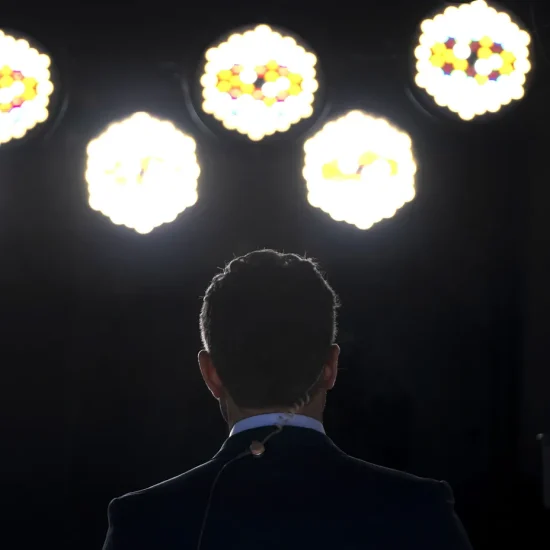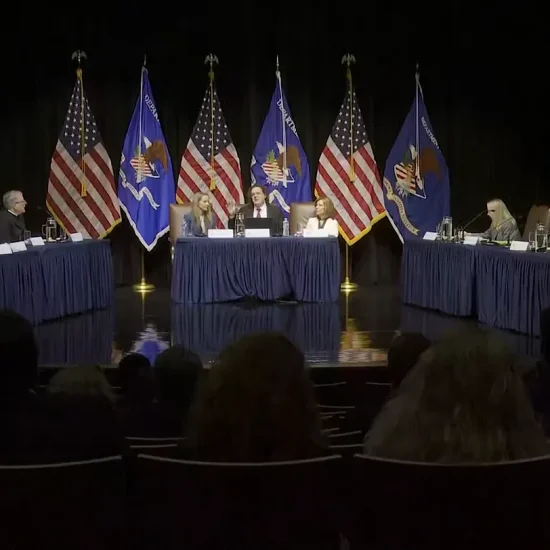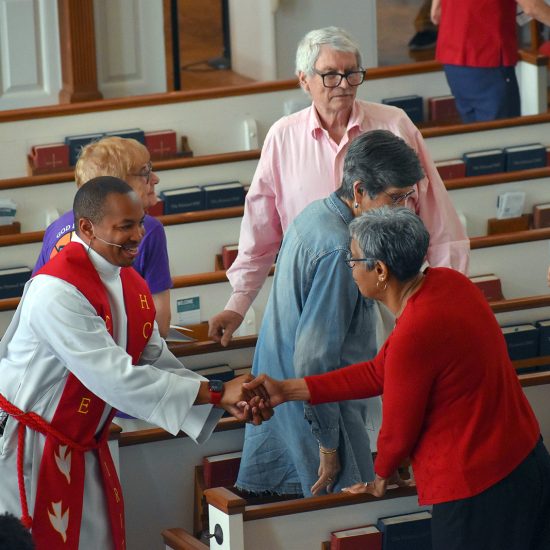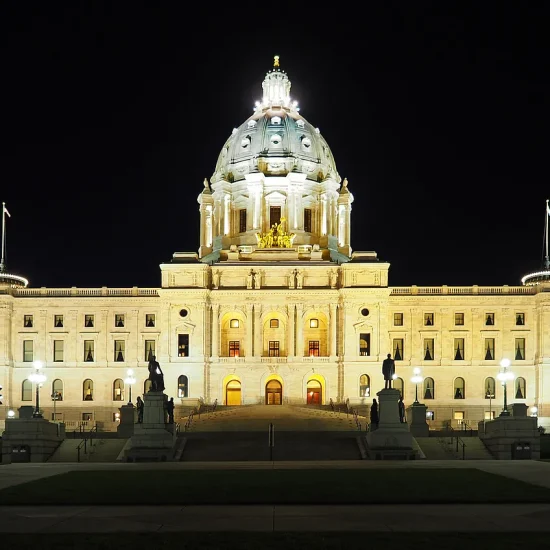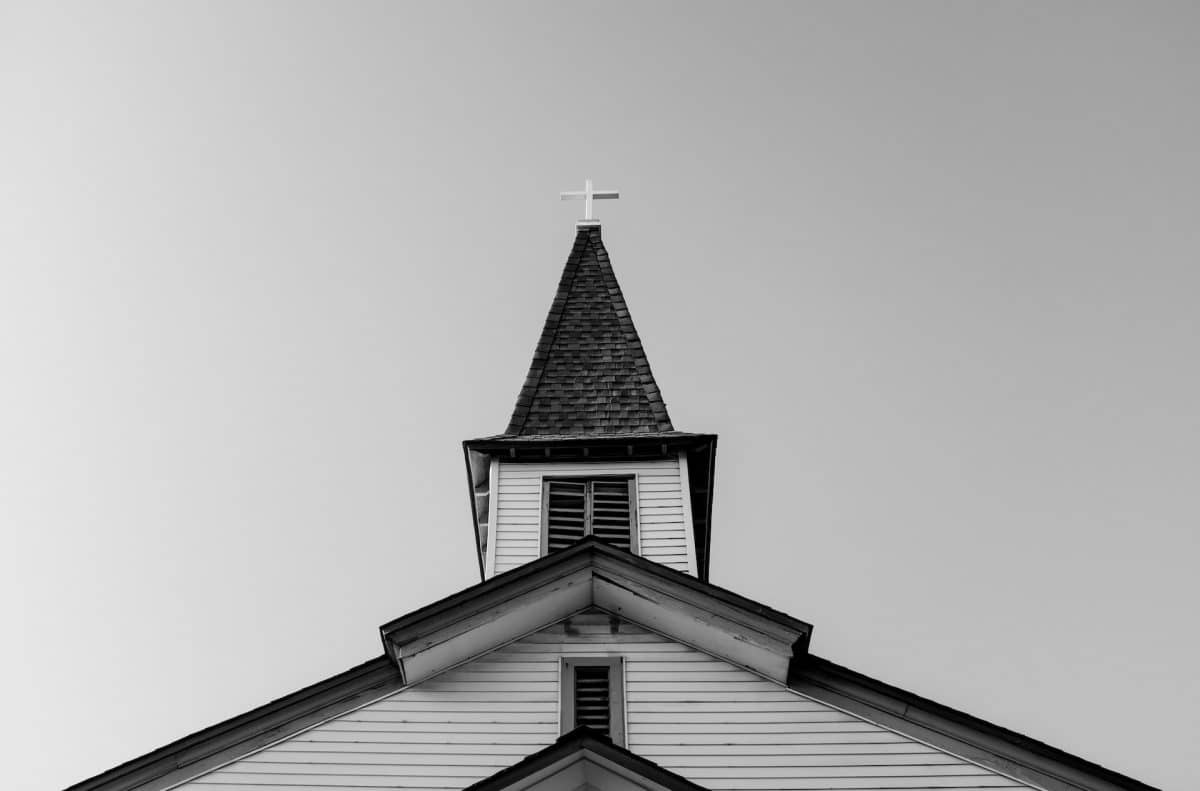
Much has been written about the terrifying parts of Christian Nationalism — about the violent and greedy legacy of an American Church built on a never-ending quest for wealth, status, and power in middle-class white America.

Angela Denker
That’s not what I’m writing about today.
Instead, I want to write about the myopia I find myself in — and maybe you find yourself in — as we stand amidst the wreckage of a compromised church, look back at our childhoods, and lament with embittered eyes how our once cherished memories have become tarnished.
Sometimes it would be easier to champion, uncompromisingly, a strong and central Church, one that can afford to take for granted its place at the center of American community and life.
I’m thinking now not of what became megachurches, with fancy stages and glittering lights and pyrotechnics and pastors with bestselling books. I’m thinking of what came before: white steeples with rows and rows of pews, filled with families. I’m thinking of what most Catholic parishes and mainline and rural churches today look back at as their glory days.
While we often think of America’s past as a devoutly Christian one, instead statistics show that church attendance in the U.S. likely peaked in the 1950s. The postwar period and Baby Boom also represented the height of denominationalism and the advent of Christian publishers and Christian radio shows.
White Christians’ memories of church in these years are often nostalgic, lacking the context that these were years still of segregated schools and Jim Crow laws in the American South, years before women could become ministers in most denominations or even before women working outside the home was considered acceptable (in white, middle-class America, that is — poor, working-class women, and women of color had long been employed outside the home as a matter of necessity).
A sense that in the 1950s all was “as it was supposed to be” betrays a hint of racism among white Christians because these years were not equally good ones for Black Americans and for non-white Americans in general. Black American soldiers were largely denied access to the life-changing benefits of the G.I. Bill, and just a few years before the 1950s, Japanese Americans had been forcibly confined in internment camps.
Still, for those of us raised in white churches in the 80s and 90s, and for parents raising kids in white churches in the 80s and 90s, there was by and large a sense of furthering or clinging onto the church’s central place in society that was experienced by Baby Boomer parents in the 50s and 60s.
For this reason, many of us attended “program” churches, churches that used an “attraction” model focused on “young families.” These churches employed attractive guitar-playing young men as “youth pastors” and organized regular youth events and mission trips in order to build a sense of community among kids in the church.
There were well-established and extensive Sunday school programs, usually led by women who perhaps in another life could have been astute CEOs, organizing dozens of volunteer teachers, and managing curriculum and music lessons for hundreds of children every Sunday.
There was VBS in the summer, the aforementioned mission trips, and camps for older kids. There were countless “service opportunities:” visits to shelters, meals to serve and pack, and yards to clean up. Once I even joined a group of junior high kids for a round of neighborhood caroling.
My church had a phenomenal youth and family ministry staff. Just excellent. While, as usual, the senior pastor got the lion’s share of the credit for the church’s astronomic growth in the 90s and early 2000s, I wondered later if more of that credit should have been extended to the youth and family staff. There were programs galore. Not just Youth Group but a variety of events for kids of all ages.
Randomly this week, as I drove from leading church alone on Sunday morning to catch my fourth-grade son’s flag football game, where the other parents just stared at me when I said I’d missed the earlier game because I was at church, I thought about 456 Club, our church’s group for fourth, fifth, and sixth graders when I was that age. We went bowling and to Dairy Queen. I remember meeting with our new youth staff member, a young woman, to talk individually about what I thought might be fun plans for the year ahead. I remember how cool and unique that was. A 20-something woman was interested in spending time with me! She wanted my opinion!
There was real value in what sometimes seemed like activities that were “just for fun,” like waterpark trips in the church’s old blue bus, or scavenger hunts at the local grocery store, or playing church games like Sardines before plopping down in the dilapidated couches across the road in what we called “The Fish House,” after the symbol of the fish used by early Christians.
Church was a place where I knew adults who weren’t related to me valued my opinions. I met married couples and young adults who gave me the chance to share brief talks as part of youth group in high school, a Monday night activity called The Living Room.
It was all innovative and energetic, and it took a huge amount of coordination, planning, and financial support – as well as adequate staffing.

Me after my fifth grade First Communion at church growing up. These are happy memories: ones I’d wanted to re-create for my kids — but so much has changed.
As a stereotypically busy high school kid, I took it all for granted, showing up sparingly when I didn’t have sports practices or games; using the service projects as ways to fulfill school requirements for National Honor Society.
After all, just in my little suburb, there were tons of churches with equally rich offerings for kids and families. For a brief period in high school, I left my mainline youth group and flirted with Evangelicalism, attending a different local congregation that also hosted a purity retreat as an alternative to our school’s “abstinence-based” or “abstinence-only” sex education.
This was in a blue Midwestern state (Minnesota) where megachurch Evangelical culture was slower to take hold, and mainliners and Catholics still make up the majority of Christians, even today.
And still, the influence of popular Christian culture weighed heavily in my experience — sometimes in ways that seemed really positive! Just like I bet many of your churches, my church had that infamous poster, listing popular 90s musical groups and suggesting “Christian” alternatives. (I remember always thinking that maybe, unfairly, Christian musicians were just people who couldn’t make it in the “real” music industry). I was cynical and untrusting and suspicious in a lot of ways, and I still attended the purity retreat and the Teens Encounter Christ retreat, and I still worried about what it might mean if my (nonexistent) boyfriend and I were “unequally yoked.” I still gossiped and slandered the SAGE group at my school as it was first getting started, laughing about it with my friends. SAGE stood for Straight and Gay Equality, and I’m embarrassed today that my gut instinct was to stand against it, probably in my head because of my Christian faith, even if my church never explicitly talked much about sexuality (JUST DON’T HAVE SEX!) was the basic message …
I remember my mom, a pastor’s kid herself, sometimes uncertain about the glossy and glitzy messages she saw us getting sometimes at our church, with a lack of theological or Biblical depth. We had a band, projector, and Domino’s Pizza before Confirmation every Wednesday night, and then my mom attempted valiantly to teach our small group and go over our “memory work.” No one had ever done their verses. One kid famously preferred to never actually speak during small group, during which his eyes were always half-closed.
But we had to meet in the kitchen because the church was so packed with teenagers every Wednesday night: three sessions of Confirmation, 4:30, 6, and 7:15. A rousing success. Church Councils today would dream of it.
I remember my mom (how she had the energy to teach Confirmation after teaching school all day, I’ll never know) one day getting fed up and going to talk to one of our pastors about the fact it seemed like kids weren’t learning much in Confirmation. It wasn’t like how she’d remembered studying the Catechism and getting in-depth into the Bible.
I’m not sure exactly what the pastor said in response, but as I remember my mom telling me, it was something about how he empathized and agreed with what she was saying, but he tended to land on the side that it was better that the kids were at least here. They were here. They were at church.
Help sustain Angela Denker’s ministry by subscribing to “I’m Listening.”
As all these memories flood back to me, positive and negative, mostly I feel kind of sad when I remember church growing up, because there are so many rich memories. I remember my dad teaching Sunday school with my friend’s dad, and yelling at the boys for tipping back their chairs. I remember being in the church plays, speaking at Baccalaureate, going on mission trips in 15-passenger vans to Philly and Richmond, Va., and sleeping on the floor in church basements; making PB&J sandwiches on an assembly line for dinner.
My kids probably won’t have these memories of church. It’s not for lack of trying. When I first became a pastor, I worked so hard to try and find a church where I could serve and where my kids could have the experience I did, leading me to two calls at very large churches in Orange County, Calif., and here in the Twin Cities.

Kenny Eliason / Unsplash
On staff, though, running a church with a $1 million+ budget is exhausting, particularly in the 2010s and 2020s. There’s this constant sense that you’re propping up a system that was never built to last. So much of your budget is going toward mortgages on massive buildings. You can’t afford health insurance for your program staff. Nobody has time to volunteer anymore, because all the parents work long hours and then move on to side hustles and ever-increasing sports and music commitments. Everybody has mounting debt and no one can afford to tithe much.
I don’t really want to be a Christian Nationalist, but what I mean by the title of this post is that sometimes I miss and even long for what churches built on money, power, and status given to me as a kid. Everything I had came at a cost, though I didn’t really realize it then. And it was mostly all good stuff! But sustaining all those programs and all that staffing and all those volunteers (many of whom were women who didn’t work outside the home, functionally working for free for the church) came at a high cost. As society changed, the churches that did programs successfully like my own just kept moving the target forward. Like American businesses and real estate, we thought the bubble could never burst. And then it did. It is. And we’re living now in the sticky mess left behind.
My kids probably won’t get a church with tons of ready-made programs built for them, where they’ll attend Confirmation class with 200 of their middle school classmates like I did.
They won’t have the option of four different mission trips or a National Youth extravaganza at a hotel.
They won’t take a bus to camp with dozens of their friends from church.
I don’t know if they’ll get to attend a baccalaureate service.
I’ll make sure they skip the purity retreat.
And in truth, it’s probably a good thing: that my kids won’t attend a church built around their enjoyment and satisfaction. They’re probably spoiled enough as it is. But as a parent who wants their kids to know and follow Jesus, what do you do instead?
What does a non-Christian-Nationalist American church look like?
Luckily, we have lots of examples. It looks like a church that’s just barely getting by. A church with a few kids and a ragtag choir. A church with a part-time minister. A church with a building that’s constantly in need of repair. A church whose building isn’t primarily used for worship. A church with an organ or piano that’s out of tune.
On good days, when I’m hopeful and reminded that Jesus didn’t die and rise again to make America Christian but instead to save the world — I’m also reminded to shift my thinking.
We — us white American middle-class Christians — invested so gol-darn much into getting people “here.” Just get them to church. Attract them. It’ll work out.
It didn’t work. Look at what the word “Christian” means to most Americans today. Doesn’t have much to do with the ministry and witness and life, death, and resurrection of Jesus — it’s more about politics and social issues and, sometimes, violence.
So if it was never about getting “them” “here,” maybe I should focus on the fact that my kids will be “there” as in out in the world, with some sense of what it means to follow Jesus in the world. As often as possible, “we” will be “here” for worship: whether that’s in person on Sunday mornings, or online, or at another time during the week. And we’ll pray before meals and dinner. We’ll talk about death and life and how Jesus stands for justice.
Maybe the kids will be OK. Maybe I can let go of giving them what I had in church and focus instead on teaching them to follow Jesus in pursuit of a better world, for everyone.
Angela Denker is a Lutheran pastor and veteran journalist. She has written for many publications, including Sports Illustrated, The Washington Post, and FORTUNE magazine. Denker has appeared on CNN, BBC and SkyNews to share her research on politics and Christian Nationalism in the U.S. Her book, Red State Christians: Understanding the Voters who elected Donald Trump, was the 2019 Silver Foreword Indies award-winner for political and social sciences. The revised edition of Red State Christians, subtitled: A Journey into White Christian Nationalism and the Wreckage it leaves behind, came out Aug. 16 and is currently available everywhere books are sold.

